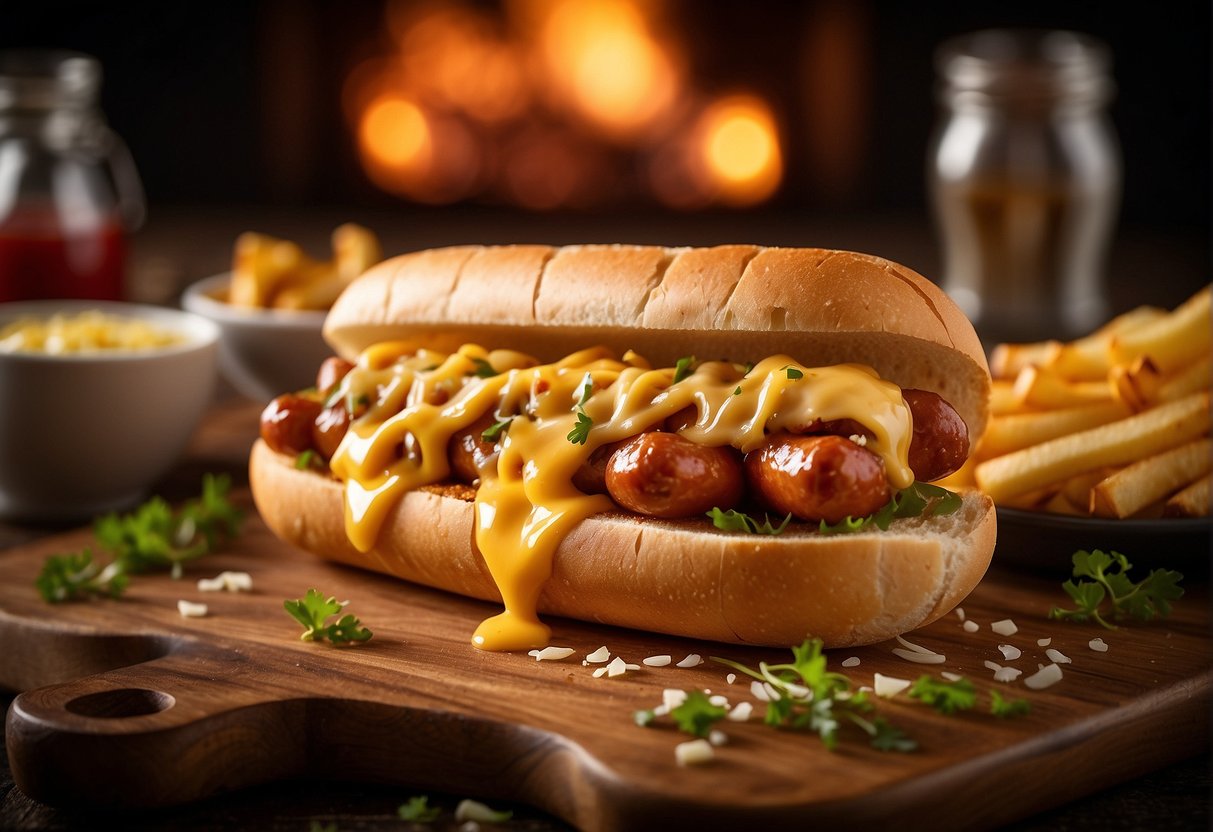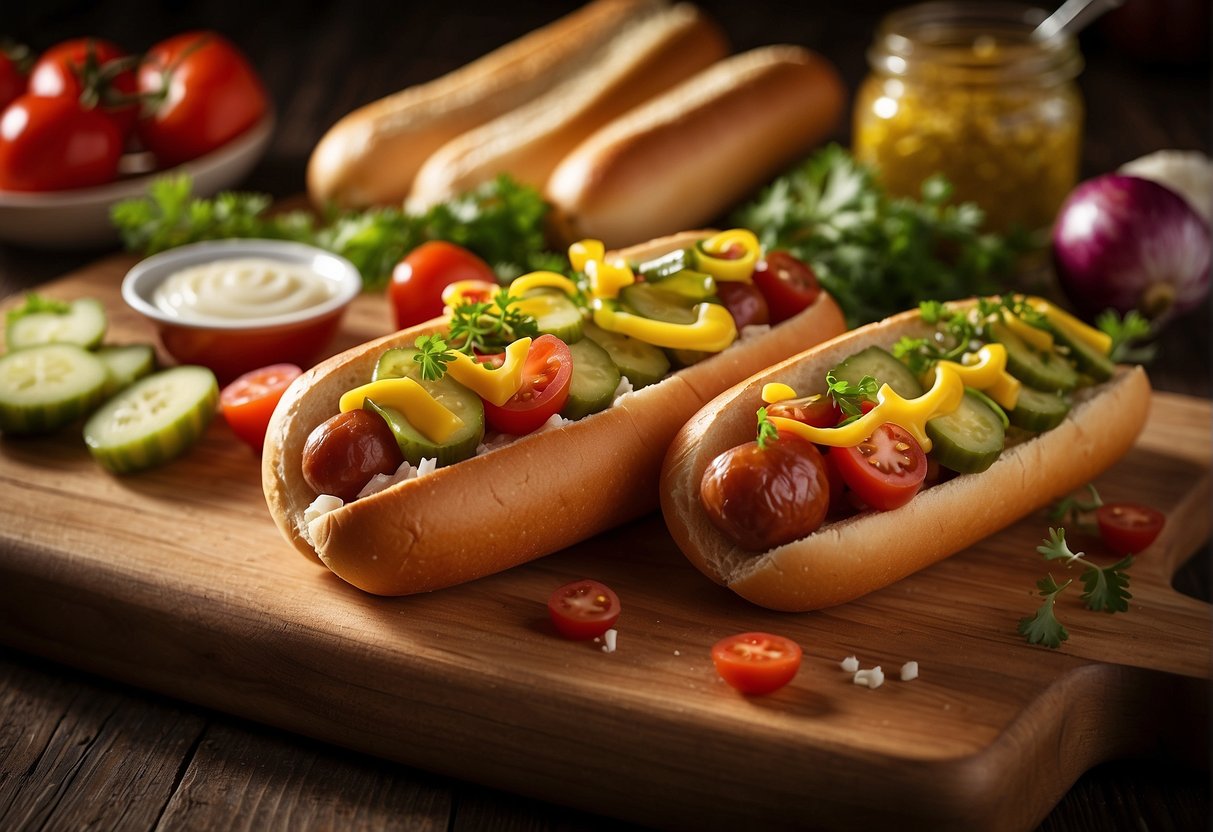The French hot dog is a delightful twist on a classic fast food favorite, embodying the elegance and culinary reputation of France in a humble yet tasteful package. Distinguished from the typical American-style hot dog, the French variation stands out with a unique use of locally ingrained ingredients and cooking techniques. It’s an embodiment of the French flair for transforming simple fare into gourmet experiences, offering a taste of France’s rich cuisine in an accessible, casual form.
Fast food may not be the first thing that comes to mind when one thinks of French gastronomy, however, the French hot dog makes a strong case for its place in the landscape of quick and satisfying eats. It’s typically composed of high-quality sausages like the Toulouse, encased in traditional French bread like a crispy baguette or soft brioche, and often adorned with a selection of gourmet toppings and sauces. Whether found on the streets of Paris or in a quaint bistro, the French hotdog is a testament to the nation’s love of good food made with attention to detail, even when it’s served on the go.
Key Takeaways
- The French hot dog is a unique fast food item that reflects the culinary culture of France.
- Quality ingredients and baking techniques are crucial to its distinct flavor and texture.
- It’s a versatile dish with regional variations, catering to a wide range of tastes.
History and Origin
When discussing the French hot dog, it’s essential to understand its unique evolution in France and how it stands distinct from its American counterpart. I’ll delve into the French interpretation of this iconic street food and the traditional American hot dog to appreciate their differences and origins.
Evolution in France
France’s adaptation of the hot dog is a marriage between the classic American Hot Dog and traditional French cuisine. Introduced around 2020, the French Hot Dog typically consists of a warm baguette hollowed out and filled with a variety of sausages, like the merguez, a spicy sausage of North African origin. This version often incorporates European Countries’ influence, with gourmet toppings and cheeses, elevating the simple hot dog to something, one might argue, more sophisticated.
Comparison to American Hot Dog
In contrast, the American Hot Dog, steeped in a rich history of immigration and adaptation, has become a symbol of American culture. It usually features a softer bun and is served with a multitude of classic toppings like ketchup, mustard, relish, and sometimes chili. While the French variant places emphasis on the quality of the meat and bread, the American style celebrates variety and abundance in its toppings.
Ingredients
The ingredients for French hot dogs bring together a variety of sausages, bread, and condiments to create a rich and savory experience. Here’s a breakdown of the key components:
Traditional Components
I consider the core elements of a French hot dog to be the sausage and the baguette. Typically, a Vienna sausage, a parboiled sausage made of pork and beef, is enveloped in a crisp, fresh baguette. Mustard, often Dijon mustard, is a classic and essential condiment for providing a spicy tang.
Sausage Varieties
Apart from the standard Vienna sausage, one could also opt for a Merguez sausage, which is a spicy mutton-based North African variety. Its rich flavors pair well with the traditional components, adding a unique twist to the hot dog.
Toppings and Condiments
A quintessential topping would definitely include caramelized onions, which add a delightful sweetness. Ketchup and mustard are the stalwarts of condiments, though I personally find that Dijon mustard offers a more authentic taste. For those who appreciate a bit of crunch and tartness, pickles or chopped cucumber lend a refreshing bite.
Bread Selection
While a classic hot dog bun can suffice, I suggest a brioche hot dog bun for those who fancy a buttery, slightly sweet alternative. The brioche bun’s rich flavor and tender texture are a perfect match for the savory sausages and bold toppings.
Preparation Methods
In my experience, there are several effective ways to prepare a French hot dog, each yielding its unique texture and flavor. I’ll guide you through some techniques that I find best enhance the classic frankfurter within a crusty baguette.
Grilling Techniques
When I grill hot dogs, I aim for that ideal balance between a smoky exterior and a juicy interior. Simple grilling can be done by placing the sausages directly on the grill, turning occasionally, until they have distinct grill marks and are heated through. For a more intense flavor, I sometimes go for the BBQ method where I let the dogs smoke slowly over indirect heat.
Baking Principles
Baking hot dogs in an oven allows for even cooking and can give the skin a slight crispiness. To do this, I preheat my oven to 350°F (175°C), place the hot dogs on a baking sheet, and bake for around 10 minutes. This is perfect when I want to prepare a large batch for guests without having to monitor them as closely as on a grill.
Frying for Crispiness
I love frying hot dogs when I’m craving that extra crispy texture. I lightly score the hot dogs and then fry them in a few tablespoons of oil over medium heat. They crisp up quickly, so I keep a close eye on them, often it only takes about 3-5 minutes to get them golden and crispy.
Reheating Tips
When it comes to reheating, I advise against the microwave if you’re aiming for quality. Instead, wrapping the hot dogs in foil and warming them in a preheated oven at 350°F (175°C) preserves the texture better. If in a rush, I use a damp paper towel and microwave on high for 30 seconds, checking every interval to avoid overcooking.
Serving and Presentation
In my experience, serving a French hotdog is about striking the perfect balance between classic comfort and gastronomic flair. The right accompaniments and plating styles are key to enhancing the overall dining experience.
Accompaniments
I always suggest that French fries be the go-to side for a French hotdog. However, I find that taking the time to cut the fries from fresh potatoes and frying them until golden adds authenticity. For a twist, I recommend sprinkling the fries with a light dusting of all-purpose flour before frying to achieve a perfectly crispy exterior.
Regarding additional sides, I’ve observed that a few pickles can bring a delightful tanginess that complements the savory flavors of the hotdog. Adding finely diced bell peppers provides a sweet crunch that contrasts beautifully with the soft buns and the texture of the sausage. When it comes to condiments, I strongly believe that cream cheese is underappreciated – it can add creaminess and a slight tang that brings a new dimension to the hotdog.
Plating Styles
Aesthetic appeal is crucial; hence, plating a French hotdog requires deliberate choices. I place the hotdog in a fresh brioche bun, slightly off-center on the plate, allowing ample space for the French fries. When it comes to gourmet presentation, I opt for adding a quenelle of cream cheese atop the hotdog, and drizzle a dark, rich sauce in a zigzag pattern for visual impact.
Lastly, embellishing the dish with a small garnish of herbs on the cream cheese or beside the hotdog shows attention to detail. I pay special attention to color contrast and balance; for example, the vibrant green from herbs against the golden hue of the bun and fries creates a visual feast that’s as inviting as the flavors themselves.
Regional Variations
In France, hot dogs take on unique flavors influenced by local ingredients and culinary traditions. From the spicy Merguez sausages to Toulouse-style infused condiments, the French hot dog is more than just a quick snack—it’s a taste of regional pride.
French Local Specialties
Merguez Hot Dog: In my experience, the Merguez sausage, rich with lamb and North African spices, is often served within a baguette, rather than the typical bun. This spicy sausage provides a robust alternative to conventional hot dog meats and is widely enjoyed across France for its deep, complex flavors.
Toulouse Hot Dog: My time in Toulouse introduced me to a hot dog variation where the regional garlic-laden Toulouse sausage is the star. I’ve noticed it’s typically topped with French onion soup-inspired caramelized white onions, melding the classic French dish with fast food convenience.
International Interpretations
- French Onion Soup Hot Dog: An international twist I’ve come across pays homage to classic French onion soup. Here, a standard hot dog is adorned with a generous portion of caramelized red onion, complete with a sprinkle of Gruyère cheese, mimicking the iconic soup’s topping.
- Parisian-Style ‘Le Dog’: A sophisticated version I’ve tasted is the Parisian-style ‘Le Dog,’ which places emphasis on high-quality, artisanal ingredients. An example would be a hot dog topped with a mild white onion chutney, elevating the typical street food to gourmet levels.
Each of these variations showcases the diversity and adaptability of the humble hot dog within the French gastronomic landscape. Whether it’s through the use of regional sausages or the reinterpretation of classic French flavors, France offers a distinct and memorable hot dog experience.
Pairings and Accompaniments
When I pair a French hot dog, I am mindful of both the beverages and side dishes that will complement the flavors. The right drink can cleanse the palate, while a well-chosen side can enhance the overall experience.
Suitable Drinks
For drinks, I find that both alcoholic and non-alcoholic beverages can serve as excellent pairings. In the alcoholic category, light and refreshing beers work well, especially Pale Ales. Alternatively, for a more refined choice, certain wines with higher acidity can cut through the richness of the hot dog; a crisp Sauvignon Blanc is my go-to. If I prefer to stay non-alcoholic, a fizzy lemonade or cola provides a sweet and tangy contrast to the savory hot dog.
Side Dish Recommendations
The classic side dish to any French hot dog is undoubtedly French fries. For a twist, I might season them with garlic powder or toss them with freshly minced garlic for a more potent flavor. Aside from fries, I often opt for a light salad to balance the meal’s richness—perhaps one with a vinaigrette to echo the acidic notes of a chosen wine.
Nutritional Information
When discussing the French hot dog, which is typically a baguette with a hot dog inside, I should mention that its calorie count can vary. A standard hot dog alone provides a substantial amount, with 189 calories and 16.8 grams of fat for a 57g serving. If I consider the entire meal with a bun, the calorie content increases.
A traditional white baguette used in a French hot dog further contributes to the calorie intake. Here’s a breakdown of the nutritional value for a typical French hot dog with a baguette:
- Calories: Adding a baguette to a standard hot dog increases the calorie count, often leading to a total of around 300-400 calories per serving.
- Fat: The hot dog contributes the majority of the fat intake.
In terms of nutritional value, hot dogs are not typically rich in vital nutrients, but the baguette may offer small amounts of fiber and some B vitamins.
| Nutrient | Amount |
|---|---|
| Calories | 300-400 kcal |
| Total Fat | Variable |
| Carbohydrates | Variable (from baguette) |
| Fiber | Low |
| Protein | Moderate |
I find it important to point out that for those closely monitoring their diet, considering the individual ingredients is essential. The hot dog itself, the type of bread used, and any additional toppings or condiments can significantly affect the overall nutritional profile of a French hot dog.
Cultural Significance
The French hot dog holds a distinctive place in both food culture and the social fabric of France. Its simplicity as a fast food item belies its deeper role as a culinary icon, reflecting the nation’s affection for convenience and tradition in gastronomy.
In French Cuisine
Despite the name, the French hot dog is notably distinct from the typical American hot dog. In France, I find this fast food item commonly served within a demi-baguette and often garnished with cheese, particularly gruyère, that’s melted to perfection. It underscores the French penchant for quality and love for their own bread culture. This variation provides a gastronomic nod to the country’s artisanal baking traditions and their penchant for marrying simplicity with flavorsome ingredients.
In Popular Culture
In popular culture, especially in France, the French hot dog represents more than just a quick meal; it is emblematic of the integration of international influences into French society. Known for a high appreciation of gastronomy, I’ve noticed that French fast food, including hot dogs, are often enjoyed in a leisurely manner compared to the rapid consumption common in other cultures. The presence of French hot dogs at festivals, street corners, and in everyday life, from Parisian arrondissements to coastal towns, testifies to its acceptance and adaptation, infusing an American concept with unmistakable French flair.
Frequently Asked Questions
In this section, I will answer some common queries about French hot dogs, detailing their unique characteristics and the traditional way they are prepared and served.
What are the distinguishing features of a French hot dog recipe?
A French hot dog typically features a brioche roll or a baguette and may include a distinct blend of emulsified sausages like frankfurters. The French style often brings a gourmet twist to this familiar street food with additional ingredients like cheese or Dijon mustard.
How is a French hot dog traditionally served in a baguette?
Traditionally, the French hot dog is served in a specially made hollowed-out baguette, allowing the sausage to nestle perfectly inside. This serves not only as a convenient way to eat on the go, but also maximizes the flavors of the sausage and bread.
Where can I find authentic French hot dogs near me?
To locate authentic French hot dogs, I recommend searching for local French bakeries or European-style delis. Gourmet food trucks also sometimes offer this French take on the classic hot dog. Websites offering local restaurant suggestions can be a helpful resource.
What type of cheese is commonly used in a French hot dog?
A common cheese choice for French hot dogs is Gruyère, known for its melting qualities and slightly salty, nutty flavor, which complements the savory sausages well.
How many calories are typically in a French hot dog?
The calorie content in a French hot dog can vary greatly depending on the ingredients used, such as the type of sausage and cheese. However, an average French hot dog might contain anywhere from 300 to 500 calories.
What equipment is used to prepare a French hot dog?
Preparing a French hot dog typically requires a bread knife to slice the baguette, a skillet or grill to heat the sausage, and optionally, an oven to melt the cheese and toast the baguette for additional warmth and crispness.















